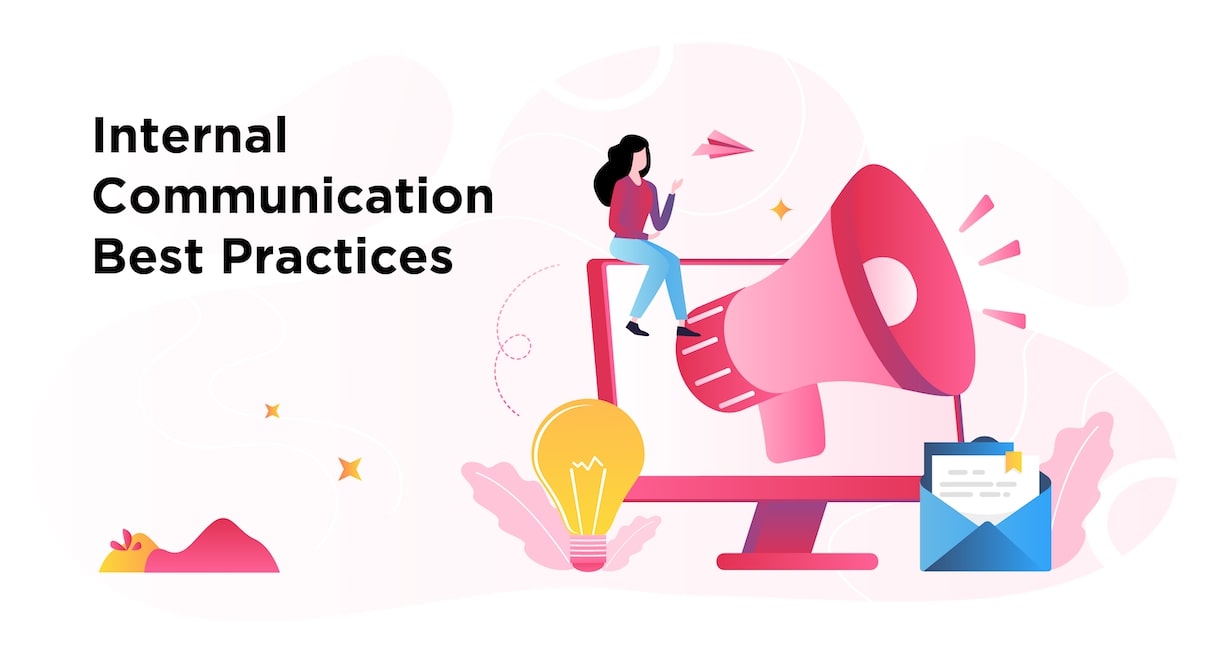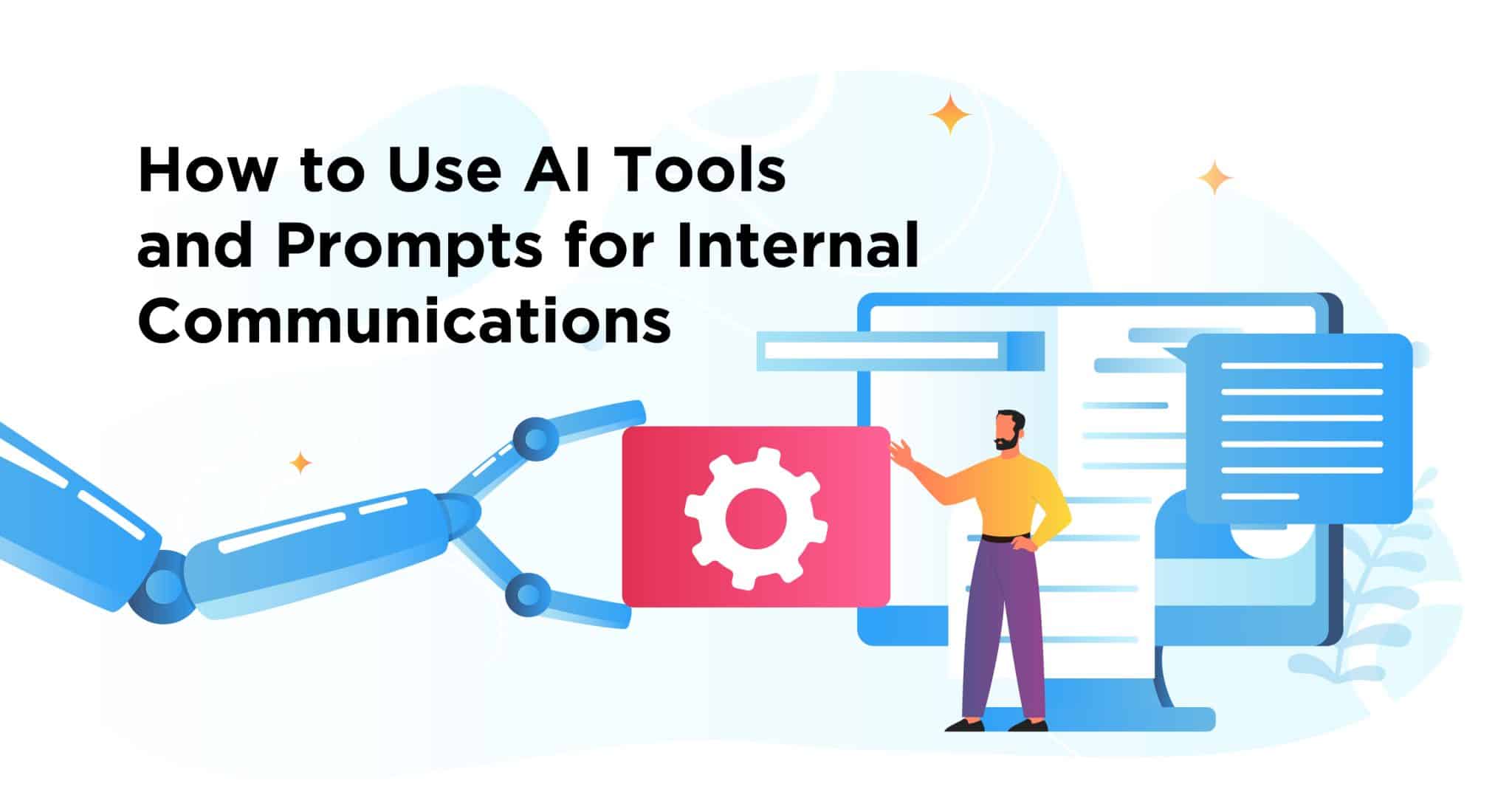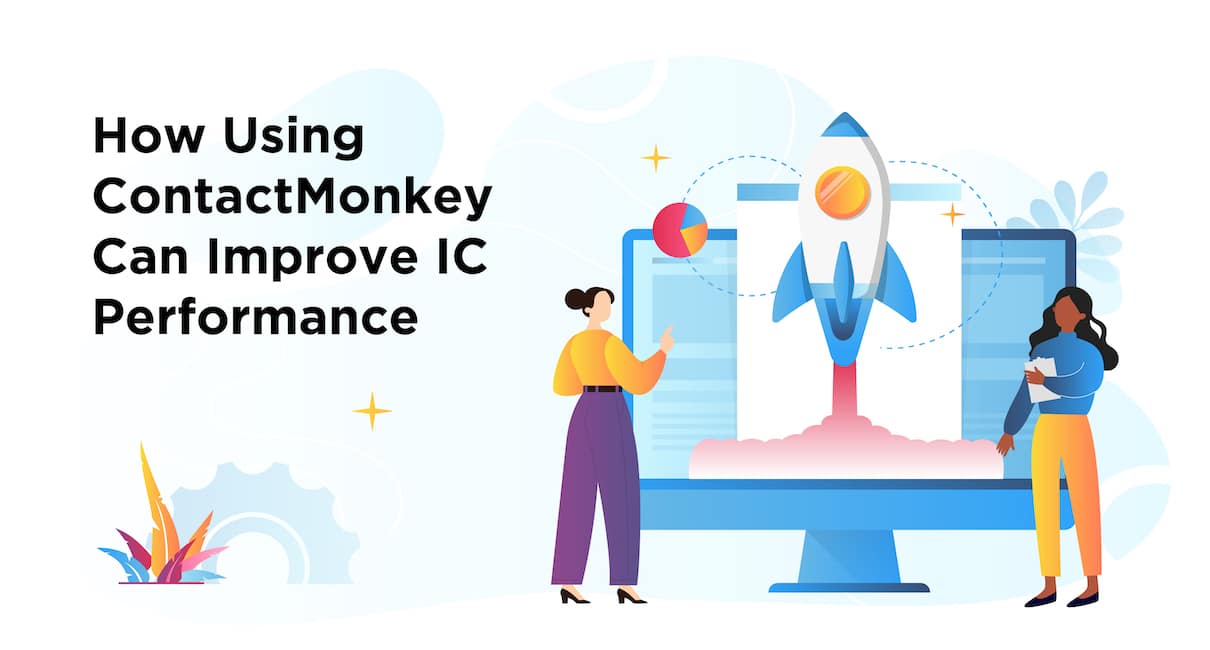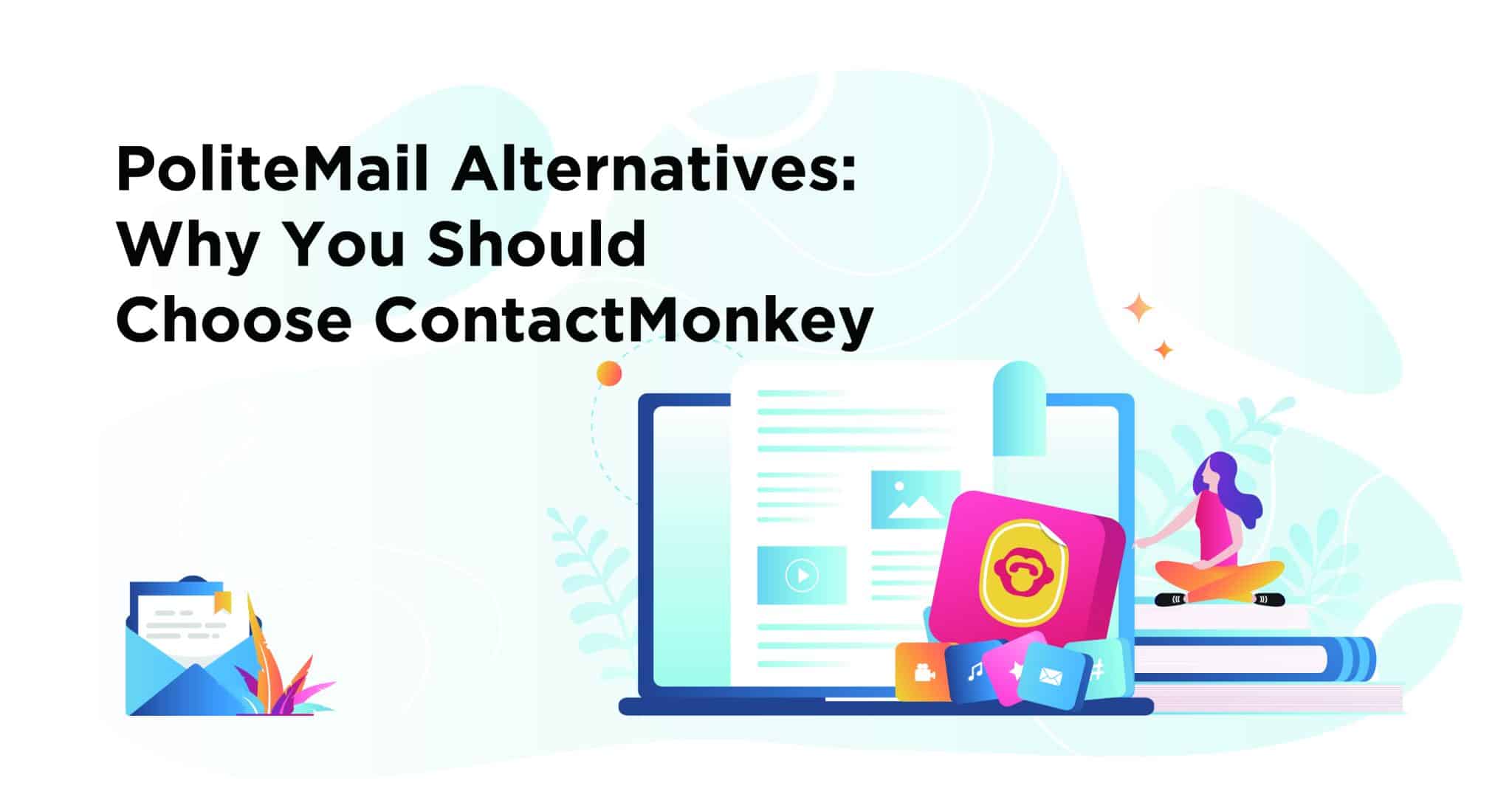Whether you’re an expert or beginner internal communicators, it’s super important to stay up-to-date on the latest internal communication best practices. We’ve collected our most effective best practices for you to apply to your business’ communications.
No two companies are identical, and every internal communicator approaches their work differently to match how their workforce is structured. But they can still apply internal communications best practices.
Why do these trends matter? Because the nature of business communication is always changing, internal communications best practices are based on communication trends. We’ve compiled a list of 14 important internal communications best practices based on the latest internal communications trends.
Pro tip: DON’T use an external marketing tool for internal communications. These tools can interfere with your employees’ ability to receive your internal emails. See why ContactMonkey is a top Mailchimp alternative designed specifically for internal communications.
14 Top Internal Communication Best Practices
Effective internal communication in the workplace is a stepping stone to more innovative products, better customer service, and more engaged employees. But it’s often easier said than done when it comes to improving your internal communications.
Start by incorporating these employee communication best practices into your strategy and building on your success.
Improve your internal comms with ContactMonkey.
Start a free 14-day trial. No credit card is necessary.
1. Track your key metrics for success
If you’re an internal communicator in an organization that has shifted to remote work, you’re dealing with an entirely new challenge. Our Number One best practice for internal communications: tracking your emails.
As part of a data-based approach to internal communications, email tracking consists of gathering quantitative and qualitative information about what you send to your employees.
Quantitative data consists of metrics like open rate, click-through rate, opens by device and location, read time, open time, and more, and give you an idea of how your employees engage with your content. This is what that information looks like visualized within ContactMonkey’s campaign dashboard:
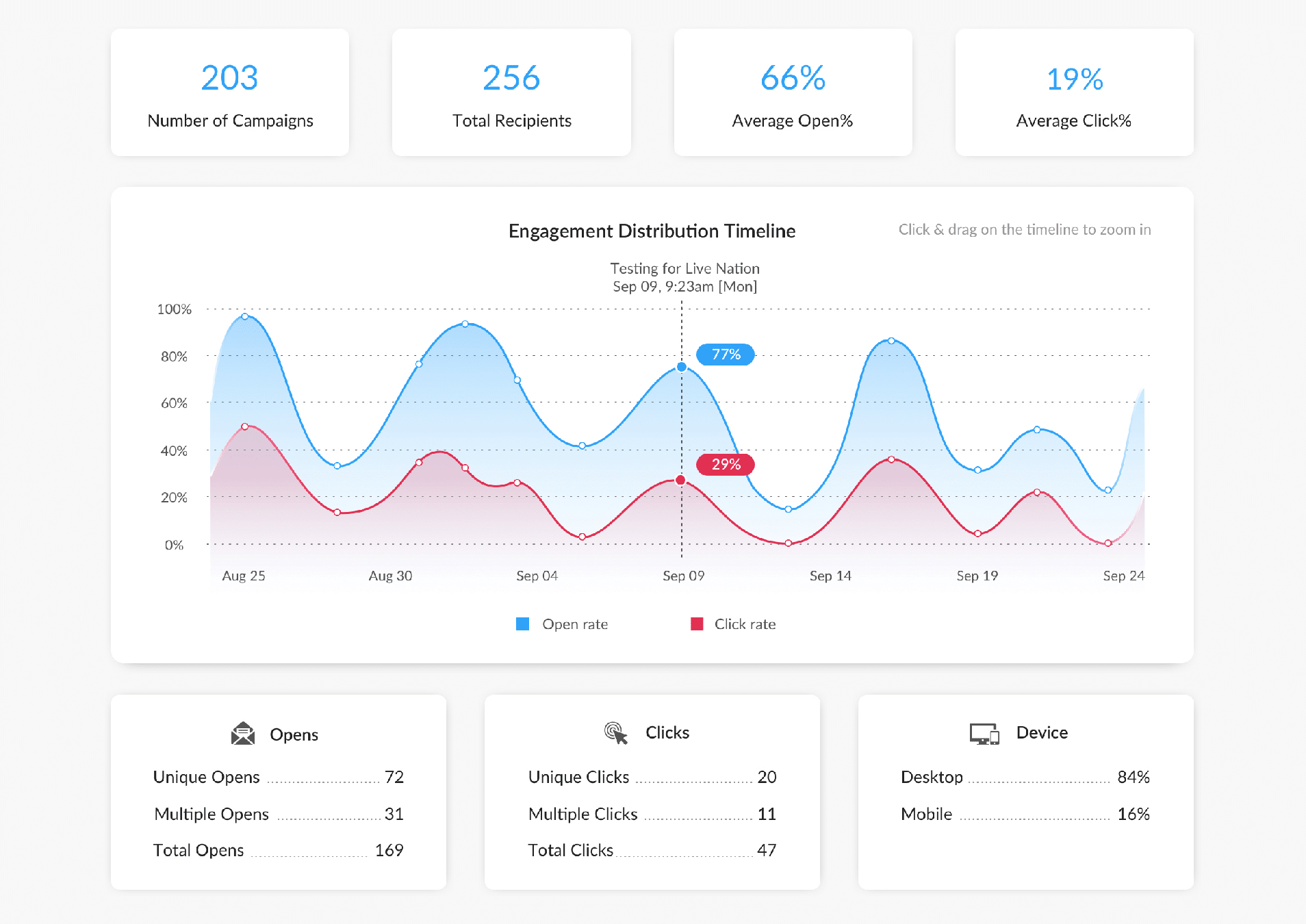
But this is only one half of the situation. To get a complete picture of your email engagement, you have to understand how your employees feel about your content. This is where qualitative feedback comes in.
Gather invaluable information by collecting employee comments, conducting surveys and polls, and creating a feedback culture with your internal communications. It can be as simple as including a question at the end of the email that asks, “did you like this email?”. ContactMonkey’s email template builder has numerous options for survey questions:

You can make easy improvements to your internal communications with ContactMonkey’s all-in-one IC software. Learn more by booking a free demo.
2. Personalize your internal communications for more engagement
You can also personalize email subject lines and body copy. Adding your recipient’s name is proven to boost open rates—which is why it’s one of our favourite internal comms best practices.

Employees are looking to their employers more than ever for information, and it’s up to internal communicators to give them what they need without overwhelming them. Focused, personalized emails sent at regular intervals can help build your internal brand voice among employees and cement trust in the organization.
As internal communicators, you need to be aware of what employees may be experiencing. Be sensitive t0 those who may be overloaded by work or personal issues, and tailor your internal communications accordingly. You can try:
- Using multimedia by adding GIFs to your Outlook emails and featuring informal videos from management.
- Solicit comments about how employees are handling similar issues.
- Sending fewer emails to avoid overwhelming employees.
That last point is important. We are using email for more things than ever since the rise of remote work, and our inboxes can fill up fast.
Internal communicators can help their emails stand out by being selective with what and when they send. Using the quantitative data gathered via Gmail or Outlook email tracking, you can send your emails at peak times to maximize open rates.
3. Create and send a regular employee newsletter
A fundamental internal communications best practice is utilizing an employee newsletter. An employee newsletter is a recurring internal email that updates employees with the latest company news, announcements, events, or any information that employees would find valuable.
There are countless advantages for implementing an employee newsletter. A well-designed newsletter will quickly inform employees about information they need to know, but will also help emphasize your company’s culture and brand voice via well-designed layouts and content. Combine your internal communications protocol with a variety of employee newsletter ideas to encourage employees to make checking your newsletter a regular part of their communications routine.
4. Integrity is key
Your employees are people in the world and are aware of these issues. If your organization ostensibly supports Black Lives Matter but doesn’t contribute to any related foundations, or worse makes donations to groups working against BLM, you can disillusion your employees and shake their faith in your authority. Not to mention gravely affect your public image.
Integrity matters.
Set up fund-raising initiatives like pledge drives and donation matching to get your employees involved. Highlight worthwhile organizations and the good work they do and encourage employees to donate and get involved.
Keeping your promises as an employer helps keep your employees dedicated and passionate about their workplaces. This is a crucial internal corporate communication best practice.
5. Communications before content
As an internal communicator, it’s easy to get caught up in producing content. But it’s crucial not to overlook how your business communicates rather than what your business communicates.
If slow communications are bogging down productivity at your business, you may need to look at optimizing your internal communications. After all, if employees are overwhelmed and not opening emails, then work isn’t getting done.
An example of an easy way to improve communication in your organization is to reduce the number of superfluous emails employees receive. You first create different groups of employees based on the information they need to receive, eliminating as much unnecessary crossover as possible.
You then create different distribution lists based on these groups to which you then send focused email content. Use ContactMonkey’s segmented email stats to track email metrics by department, location, and more to measure your success.
Create distribution lists in case of emergencies, so you can quickly act on your crisis communication plan to ensure employee safety.
With ContactMonkey’s List Management feature, you can create your own custom email lists without needing IT. Your custom email lists can be integrated with your Human Resource Information System (HRIS) like Workday and ADP, as well as Azure Active Directory, so they’ll update automatically.
Using an internal communication software like ContactMonkey you can send and track emails to your Outlook distribution lists and Google Groups.
6. Gather employee feedback regularly
Workplace culture and internal communication are closely linked. If you want to build a strong, collaborative company culture, your employee communications shouldn’t be a one-way stream. Instead, they should create a conversation between your teams.
You can start building dialogue by asking company culture questions, embedding pulse surveys, and adding comment features in your email newsletters. With ContactMonkey, you can enable commenting to let employees leave anonymous comments after clicking on a survey option. These comments will appear on the same dashboard as your tracking data:

Email tracking is an essential email newsletter best practice for any internal communicator. By collecting employee feedback, you can easily hone in on your best content, see which employees are most engaged, and prove the value of internal communications to the C-Suite.
You may ask employees what they think about a piece of industry news or how they feel about your company’s new change management initiative. Whatever the topic you choose, the conversational dynamic will promote a healthy two-way communication stream across your workplace.
With ContactMonkey, you can easily boost your internal communications and create conversation through an easy-to-use pulse survey tool. Whether you’re sending a monthly employee newsletter, higher education communications, or yearly leadership communications, pulse surveys can help you gain employee feedback from all your internal emails.
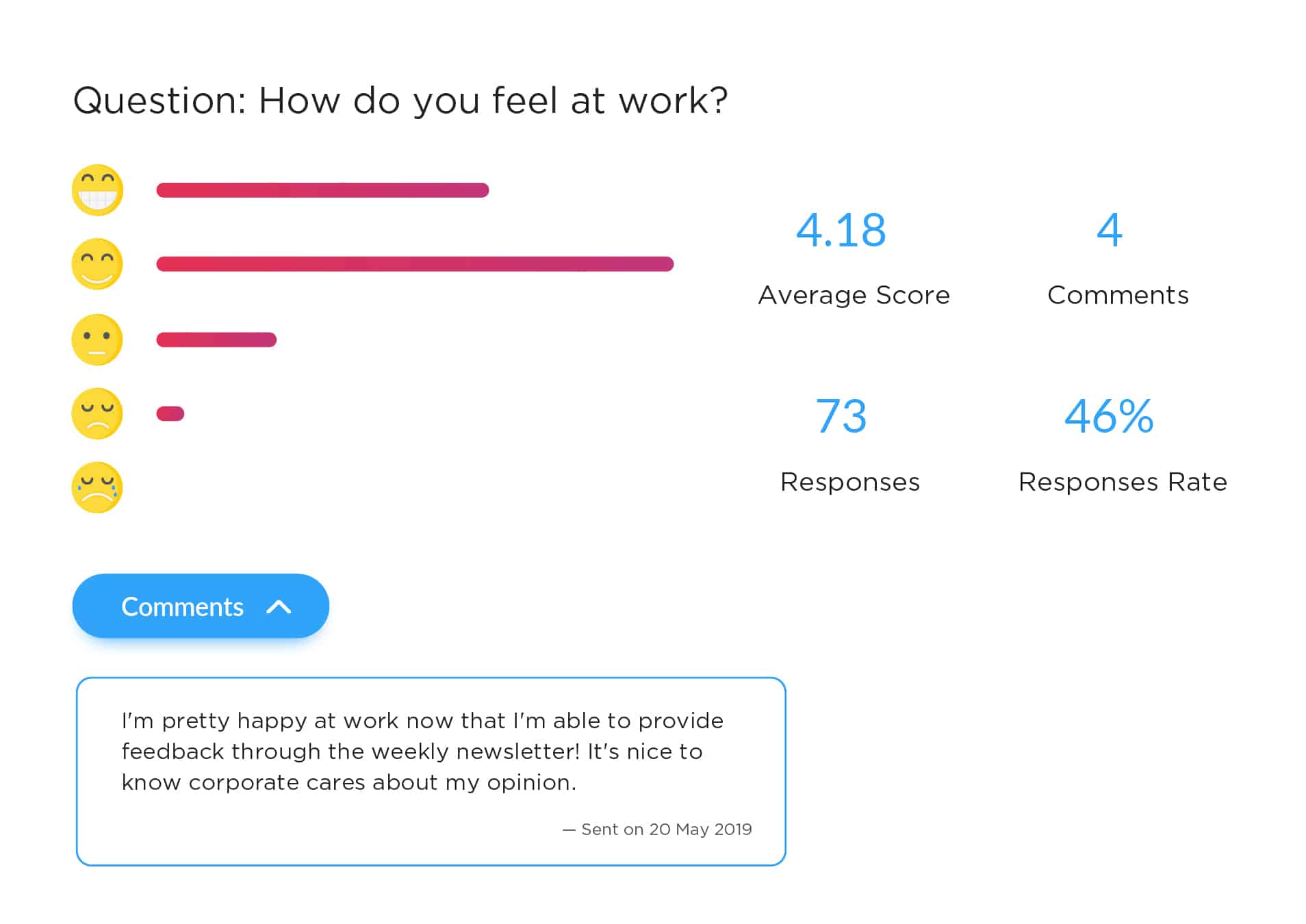
Employees can react and comment on newsletter content using emojis, star ratings, anonymous feedback, and more. On your end, you’ll be able to track survey response rates and see comments using your analytics dashboard:
7. Celebrate team successes with employee recognition
Employee recognition is a key driver of employee engagement. When employees feel that their own efforts or those of their team are being recognized, they’re much more motivated in their work.
And who wouldn’t be? We all want credit where credit is due.
Celebrating employee successes also helps showcase your company’s strengths and inspires your employees through shared goals.
That’s why incorporating employee recognition ideas into your internal comms best practices is key.
As you begin on your internal communications plan, look for opportunities to recognize employees and showcase team successes. It could be something as simple as an associate of the month feature in your employee newsletter. Or it could be spotlighting a new project that one of your team’s completed.
ContactMonkey’s drag-and-drop email template builder makes it super easy to add these features into your email newsletters:
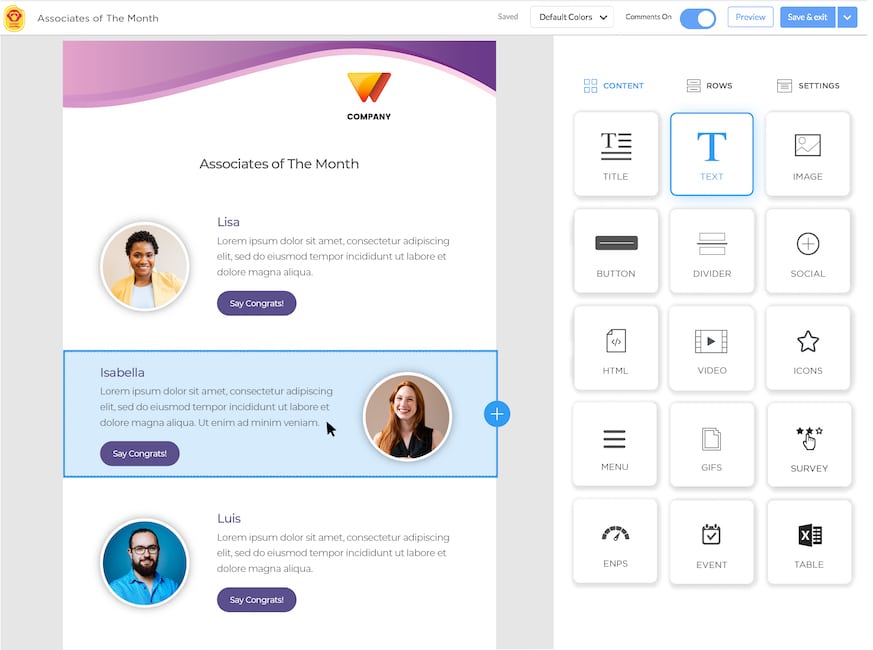
8. Conduct an internal communications audit
We’ve previously talked about the importance of conducting an internal comms audit to set you up for future success.
There are tons of reasons why an internal communication audit is an important best practice for effective internal communications. If you’re an organization that’s looking to figure out how to make sense of your internal comms data and need a baseline to measure certain things against, an audit may be the way to go.
Or perhaps you’re looking to create an internal communications plan and want to conduct an audit in the hopes that it’ll help you be more strategic with your decision-making skills.
Whatever your reasons are for conducting an internal communications audit, it’s an excellent idea to do so now at the beginning of the year so you can gauge what worked previously and what didn’t and set some concrete goals to help you succeed this year!
This is definitely one of the top internal communication best practices you should aim to adopt in 2023.
9. Measure and optimize your internal communications
While internal communications audits are usually performed on lengthy interval, there are other things you can do to refine your internal communications in the short term. We’ve already mentioned how internal email metrics can help you pinpoint what content your employees prefer to see, but that’s just the tip of the email analytics iceberg.
Using features like ContactMonkey’s Reporting, you can measure your internal communications to determine your best-performing internal communications based on who view them and how often. Segmented email stats shows you a breakdown of your email metrics by department, title, and office location:

These statistics work two ways. They show you your most (and least) engaged segments of your internal communications recipients. And when combined with campaign comparisons, they help reveal what email content drove that engagement. We explore how to use these features in conjunction with each other in our blog on internal email campaign analytics.
Does your organization have internal or external regulations around email privacy? With ContactMonkey’s anonymous email tracking, you can gather email metrics while maintaining your employees’ privacy.
10. Getting back to “normal”
Making your emails feel relevant post-COVID can be a challenge, but utilizing some of what we have covered already will help grab and hold your employees’ attention:
- Keep your emails to the point; only include information relevant for that audience.
- Send emails regularly at peak times to maximize open rate.
- Use engaging multimedia to convey information.
- Personalize subject lines and body copy to grab their attention.
Ultimately, getting your internal communications to matter to your employees will differ depending on the situation at your company. But making an effort to build employee engagement via internal communications should be an employee communication best practice for every business in 2022.
11. Schedule your internal emails in advance
Planning your internal communications in advance has numerous benefits:
- Avoid last-minute scrambling to send out internal emails.
- Keep content fresh and avoid overly-repetitive emails.
- Boost email engagement by sending emails when your employees are most likely to read them.
- Schedule weekly, monthly, and yearly emails to build your internal brand voice and avoid overwhelming your employees.
Using ContactMonkey’s internal communications calendar combined with our email scheduling features, you can ensure your send your employees the right emails at the right time.
12. Stay ahead of trend for internal communications tools
Internal communications is always changing, and IC pros stay on top of the latest internal communications tools, methods, and procedures.
Make internal communications research a part of your internal communications strategy. Set time aside for your team to learn about the latest innovation in internal comms. Try scheduling a weekly lunch-and-learn meeting where your team can discuss internal communications trends and share resources.
13. Reach all your employees with SMS communications
The best practices for effective internal communications will depend on how your employees interact with your emails. Many companies have employees who do not have easy access to computers or laptops, instead relying on their mobile devices as the main internal communications channel between them and their employer.
SMS employee communications is an employee communication best practice for businesses with a frontline, deskless, or on-site workforce. When you follow SMS best practices, text messages can reach your employees in an instant. It becomes easy to quickly and concisely convey information and updates employees need immediately.
Crisis communications, shift changes, weather updates, and more can all be communicated effectively via SMS text messages—and even faster using SMS text message templates.
Using ContactMonkey’s SMS text features, you can draft and send text messages using the same CSVs you use to organize your internal emails. All of this is easily accessible within your SMS text message dashboard:

Easily manage your employee SMS text messages alongside your internal emails with ContactMonkey. You can also download a free set of SMS text message templates here:
14. Professionally manage your company events
While company events aren’t technically employee communication best practices in themselves, how you manage them via your internal communications certainly is. After all, if your employees aren’t properly informed about your upcoming events, your overall attendance and engagement is going to suffer.
Formalizing your internal communications approach to advertising your events and collecting RSVPs is an effective way to improve turnout among your employees. Use your internal newsletter to feature reminders about your upcoming events, listing the date and time when they’ll be taking place.
With ContactMonkey you can take this approach one step further. ContactMonkey’s event management features make it super easy to embed event invitations directly into your internal emails. These invitations list all the details of your event, and allow employees to RSVP directly from their inboxes:

Not only can they send in their RSVP, but employees can also include comments with their reply. These comments can help inform your approach to the event, like what parts will be most useful to your employees. This kind of employee feedback can help you refine your events to be more engaging and insightful.
Get Serious About Internal Communications
Our 2022 internal communications best practices are applicable for all businesses. Whether your internal communications department is in its infancy or consists of 20+ team members, changing your strategy to reflect communication trends is essential.
If you’re looking to boost your internal communications, we highly recommend learning how to use an internal communications software like ContactMonkey.
With ContactMonkey, it’s a breeze to create, send, and track employee emails and newsletters. Make our all-in-one internal comms software a part of your New Years internal comms resolutions!
Ready to crush your new year internal comms goals? Want to learn how to track your internal comms using ContactMonkey? We can set up a personalized demo for you and your team. Just click on the button below to book your demo!

